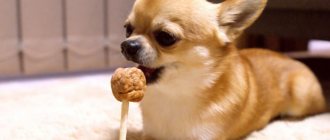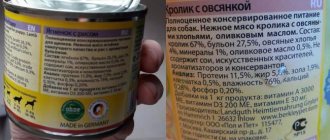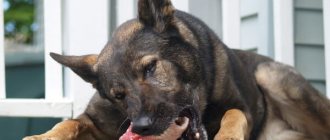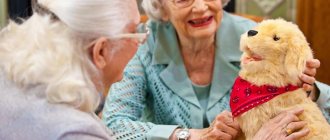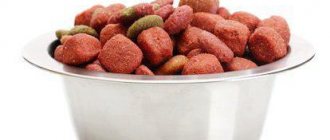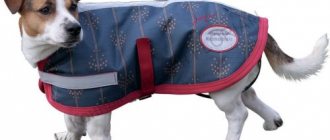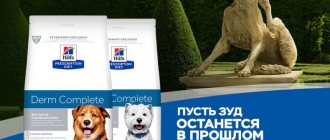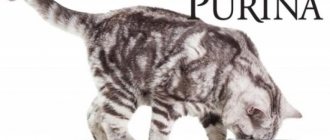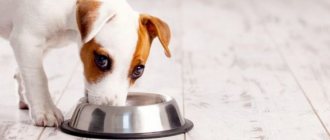As the animal ages, it becomes less active and eats and sleeps more. This has nothing to do with laziness. The main reason is the natural slowdown of metabolism. An older animal begins to gain weight while maintaining its previous diet. In this regard, veterinary experts strongly recommend gradually changing your pet’s diet, reducing the total calorie content of the diet without losing useful and nutritious elements.
Manufacturers of ready-made kibble and wet food have developed diets taking into account the basic needs of an old dog. It is important not only to reduce the caloric content of such a diet, but also to maintain a balance of nutrients such as fatty acids and antioxidants. All this is necessary for the successful long-term functioning of the immune system and the maintenance of the joints of an aging dog.
At what age does a pet reach old age?
A dog's old age does not occur immediately: irreversible processes in his body occur gradually. Veterinarians classify those pets that have reached the age of 7-8 years as elderly. In addition, the onset of old age is influenced by the size of the dog and its breed:
- In dwarf and small breeds, this period begins at 9-10 years.
- In medium and large breeds, old age occurs at 7-8 years
- Giant dogs age from 6-7 years.
It is not difficult for even the most attentive owner to notice signs of changes. Chronic diseases, loss of motor activity, decreased visual acuity and decreased appetite are signs that your pet is aging. At this moment, the owner begins to think about what to feed his old dog.
What you should absolutely not give
A dog, whether young or aging, should not be given table scraps. Old dogs need to be fed correctly. The following products are completely prohibited:
- fish, chicken, tubular bones;
- spicy/smoked/pickled food;
- alcohol, sweets;
- yeast baked goods;
- coffee Tea;
- unheat-treated river fish;
- milk;
- fresh eggs;
- persimmons, plums, peaches;
- currants, raisins, grapes;
- pineapple, kiwi, citrus fruits;
- avocado;
- raw cabbage;
- potatoes in any form;
- onion garlic;
- fruit seeds.
The range of industrial feeds is varied. Finding a product that meets the needs of an older dog is not difficult. But if the owner prefers to prepare food for the pet on his own, then the recommendations of veterinarians must be strictly followed. Food should not just be tasty, but as healthy as possible.
Features of older animals that affect their nutrition
Why is it worth reviewing the old menu and changing it to a more suitable one?
Reduced activity
Having reached a certain age, the once active individual begins to spend more time on the sofa or in the kennel. She does not want to run or accompany a person on walks not because of laziness - she begins to have problems with joints, muscles, and bones. This causes discomfort and even pain to your four-legged friend. The pet will now prefer slow walks in the park and is unlikely to rush to catch up with a stray cat.
This rhythm of life must be approached with understanding: you should not take an elderly dog for active jogging or long hikes. But regular leisurely walks in the fresh air are vital - they will help maintain the old man’s muscle tissue and bones in normal condition.
As activity decreases, so does the need for calories. Now, any excess of the norm is fraught with obesity or liver problems.
Problems with teeth or jaw
Just like humans, four-legged animals' teeth deteriorate after a certain age. Problems in the oral cavity become noticeable due to a specific odor, plaque and tartar. If a young individual could easily get rid of these problems with the help of solid food, then a mature representative, due to the characteristics of the body, is not able to do this.
As a result, inflammation and ulcers appear on the gums. They cause pain, and the pet begins to refuse food.
Even if the owner treats dental problems in a timely manner, it is difficult for the dog to chew pieces that are too large and too hard. Therefore, natural products are finely chopped or ground in a blender, and when dry feeding, smaller granules are chosen.
The emergence of chronic diseases
Due to disturbances in the gastrointestinal tract, difficulties begin with digesting food. Against this background, chronic constipation and allergic reactions even to familiar foods appear. This must be taken into account when preparing an old dog’s diet, excluding some treats.
Attacks of urinary incontinence are also common in pets. They are explained by the development of cystitis or the presence of inflammation in the prostate gland.
With age, visual acuity drops sharply and cataracts begin to develop. Cloudiness of the lens is like a cataract that changes the angle of refraction of the light ray.
Other chronic diseases that develop in old age include cardiovascular pathologies and diabetes mellitus. These are very dangerous illnesses that can greatly shorten the life of a pet. It is recommended to be examined by a veterinarian at least once every 3 months, and also to buy food that is prepared specifically for animals with chronic diseases: kidney disease, urolithiasis, diabetics and others.
Summing up
- Old age cannot be cured. However, you can extend your pet’s life and improve its quality, including with the help of a proper diet.
- The diet of an old dog should be based on proteins and fats of animal origin.
- Special food is not necessary. It is much more important that the product used is of high quality and suitable for the pet.
If you still have questions about feeding old dogs, ask our consultant in the chat. We will give competent answers and help you choose a ready-made diet.
Diet: feeding frequency and portion size
Experts recommend feeding an elderly dog twice a day. These are morning and evening meals. Pets consuming ready-made food should be given the amount of product recommended by the manufacturers.
If there are no special instructions on the packaging, then you need to recalculate yourself. An auxiliary calorie table is used for this.
| Breeds | Number of calories per 1 kg of weight |
| Dwarf (up to 5 kg) | 100-120 |
| Small (5 to 10 kg) | 55-95 |
| Medium (from 10 to 20 kg) | 70-80 |
| Large (from 20 to 30 kg) | 60-70 |
| Giant (from 30 to 50 kg and above) | 55-65 |
The daily intake of natural food depends on the size of the elderly dog and is 4% of the total weight. The serving size also depends on the animal's appetite. If he does not eat the proposed amount within 15 minutes, then it is recommended to remove the bowl with the remaining food. Then the pet will have time to get hungry before the next meal and will eat with great appetite.
What not to feed
The prohibitions for older pets are approximately the same as for young ones. You cannot give:
- smoked/fatty/fried/marinated/canned foods;
- bread, pasta;
- sugar in any form, sweeteners;
- mushrooms, beans;
- onion;
- hollow bones, boiled bones.
The list goes on and on. In order not to get lost, remember one rule: if food is considered unhealthy and harmful to humans, then 100% of it cannot be given to an animal.
It is not recommended to feed pets (of any age) food/natural food based on wheat or corn porridge. These are practically empty calories that provide little benefit to the animal’s body.
Natural food for older dogs
Food for the old man should be low in calories and must be well digested. The condition of the gastrointestinal tract and the entire body of the animal depends on this.
Authorized Products
Natural food for aging dogs can be difficult to achieve the right balance of nutrients. Therefore, the owner must be very careful when preparing the dish. Standard porridge with meat should be enriched with vegetables, and do not forget about additional feeding. Basic foods for feeding:
- lean meats and offal;
- boiled and raw vegetables and fruits;
- low-calorie fermented milk products and 5% cottage cheese;
- cereals (buckwheat and rice, oatmeal).
A veterinarian can give a lot of useful advice on the natural nutrition of a particular individual. After examining the pet, he will tell you what food will be optimal for the menu. By adhering to his advice and the principles of a balanced diet, you can significantly improve your pet’s condition.
Prohibited Products
Prohibited products for the elderly include approximately the same ingredients as for the young. Pity for an aging four-legged animal should not be manifested in feeding it harmful treats from the master's table. The following are strictly prohibited:
- fatty meats and fish;
- flour products;
- sweets and chocolate;
- berries and beans;
- tubular and boiled bones;
- smoked, fried or pickled foods.
It is better to exclude corn and wheat from cereals for making porridge or soup. They contain mostly empty calories that provide minimal benefit to the animal's body.
Vitamin supplements
Enriching the diet with vitamin and mineral supplements has a positive effect on the condition of the body. Properly selected elements activate metabolism, normalize the functioning of the central nervous system, and accelerate blood supply to internal organs. To maintain the health of an aging pet you need:
- zinc – slows down aging;
- calcium – strengthens bones and muscles;
- glucosamine – promotes joint elasticity;
- lecithin – accelerates the absorption of nutrients;
- proteins - increase muscle mass;
- L-carnitine – normalizes the functioning of internal organs.
Prescribing vitamins on your own is very dangerous. For example, sodium, magnesium and phosphorus negatively affect the functions of the vascular system, leading to the development of urolithiasis and increased blood pressure. Your veterinarian will tell you what vitamins you should enrich your diet with after examination and testing.
Natural food
An ordinary natural meal is porridge with meat, often with the addition of some vegetables (carrots, etc.) and feeding in the form of eggs. Aging dogs have their own needs and problems, so in the last stages of her life, nutrition will have to be slightly reconsidered:
- more fiber (vegetables, bran, vegetable oil) to prevent constipation;
- sometimes the meat needs to be ground so that a dog with problem teeth eats comfortably;
- A complex of vitamins for dogs will “save” you from joint problems.
Dry food for older dogs
Properly selected high-quality dry food is ideal for feeding older pets. The presence of useful components in their composition makes it possible not to use additional vitamin supplements.
Choosing a dryer for breeds of different sizes
When choosing dry granules, you should give preference to products from a well-known manufacturer. A carefully balanced composition helps regulate the animal’s weight due to reduced fat content and increased fiber content.
For older dogs of large breeds, dry food is offered in the form of large granules. For older dogs of small and medium breeds, the granules in dry food are much finer. Thanks to this, there are no problems with chewing and swallowing food.
Combination of wet and dry foods
Most veterinarians and breeders talk about the need to combine two types of food for dogs over 7 years old. Both products are useful and can effectively complement each other, so it is better to alternate them in your pet’s menu.
For example, older dogs eating dry food has a good effect on the cleanliness of their teeth. By chewing the granules, dogs get rid of plaque and tartar. Fiber in dry food has a beneficial effect on the functioning of the gastrointestinal tract.
Wet food helps saturate the body with fluid, which serves as a good prevention of problems with the urinary system. The variety of flavors and soft consistency of the product will definitely appeal to elderly people with dental diseases.
When to choose a treatment line
In older pets, chronic diseases begin to worsen with age. A special medicinal line of food can cope with their consequences.
Therapeutic food for aging dogs is part of a complex therapy that can only be used as prescribed by a doctor. Independent selection of specialized food for your pet often leads to negative consequences.
Special food Acana and Orijen Senior Dog
The modern pet market offers food for different age categories, including those designed specifically for aging animals. Typically, the name of such products contains the mark Senior, “for the elderly,” or something similar in meaning.
We have two such foods in our assortment - Acana Senior Dog from the Heritage line and Orijen Senior Dog. These diets are distinguished by:
- high content of meat ingredients;
- moderate amount of fat;
- absence of grain and potatoes;
- relatively low calorie content.
All this helps control the weight of older dogs without significant loss of muscle mass. A variety of meat and plant ingredients allows the body to provide the entire spectrum of nutrients in an easily digestible form. Freeze-dried liver serves as a natural flavor and aroma enhancer, which is extremely important for older animals whose senses become dull due to age.
Liver
Liver is an extremely nutritious product, rich in vitamins and microelements. Feed small amounts regularly. Liver should not make up more than 5% of the total diet. For a 23-kilogram dog, 30 grams of liver daily is enough. An 11-pound dog can eat 15 grams of liver daily or 30 grams every other day. Tiny dogs will eat less than 15 grams each day, while a 45-pound dog might eat 60 grams per day or 120 every other day.
